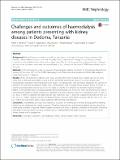Challenges and Outcomes of Haemodialysis among Patients Presenting with Kidney Diseases in Dodoma, Tanzania
View/
Publication Date
2017-07-04Type
Article, Journalviews
downloads
Metadata
Show full item recordCitation
Meremo, A.J., Ngilangwa, D.P., Mwashambwa, M.Y. et al. Challenges and outcomes of haemodialysis among patients presenting with kidney diseases in Dodoma, Tanzania. BMC Nephrol 18, 212 (2017). https://doi.org/10.1186/s12882-017-0634-2
Abstract/
Background: Kidney Diseases contribute a significant proportion to the global burden of non-communicable diseases. Haemodialysis services as the main modality of renal replacement therapy in most resource limited countries is only available in few cities and at higher costs. The aim of this study was to determine the challenges and outcomes of patients who were on haemodialysis at the University of Dodoma (UDOM) haemodialysis unit in Tanzania. Methods: In this retrospective study; we reviewed haemodialysis registers and charts of 116 patients dialyzed from January 2013 to June 2015 at The UDOM haemodialysis unit. Data were descriptively and inferentially analysed using Stata version 11 software. Results: Of the 116 patients, 52 (44.9%) were male, and 38(32.8%) were married. Their median age was 45 years. Thirty-two (27.6%) had acute kidney injury, of them 26 (81.3%) patients had recovery of renal function after haemodialysis. Indications for hemodialysis were anuria (18), intoxications (14), electrolyte imbalance (9), uraemia (7) infections (6) and fluid overload (4). Eighty-four (72.4%) patients had End Stage Renal Diseases (ESRD), of which 37 (44.1%) absconded/lost to follow up, 15 (17.9%) died, 22 (26.2%) were referred to Muhimbili National Hospital (MNH), 12 for possible kidney transplant abroad after haemodialysis, and 10 (11.9%) were still attending our unit for haemodialysis. Residing outside Dodoma was predictive for poor outcomes while on haemodialysis (OR 5.2, 95% CI 3.2-8.6, p < 0.001). In addition the odds ratio for poor outcomes was 7.3 times for a patient ESRD (OR7.34, 95% CI 3.26-18.17, p < 0.001). Patients who had no National Health Insurance Fund (NHIF) coverage (OR 6.6, 95% CI 5.4-12.7, p < 0.001) also had higher odds of poor outcomes after starting haemodialysis. Conclusion: Unavailability and high costs related to utilization of haemodialysis services among patients needing dialysis are the challenges for better outcomes. Therefore, haemodialysis and renal transplants services should be made easily available in regional referral hospitals at reasonable costs. In addition, members of the public should be educated on joining health insurance schemes and on making healthy life style choices for preventing chronic kidney disease and its progression.
Further Details
Open Access This article is distributed under the terms of the Creative Commons Attribution 4.0 International License (http://creativecommons.org/licenses/by/4.0/), which permits unrestricted use, distribution, and reproduction in any medium, provided you give appropriate credit to the original author(s) and the source, provide a link to the Creative Commons license, and indicate if changes were made. The Creative Commons Public Domain Dedication waiver (http://creativecommons.org/publicdomain/zero/1.0/) applies to the data made available in this article, unless otherwise stated.
Publisher
CrossMarkCollections
- General - GEN [367]

